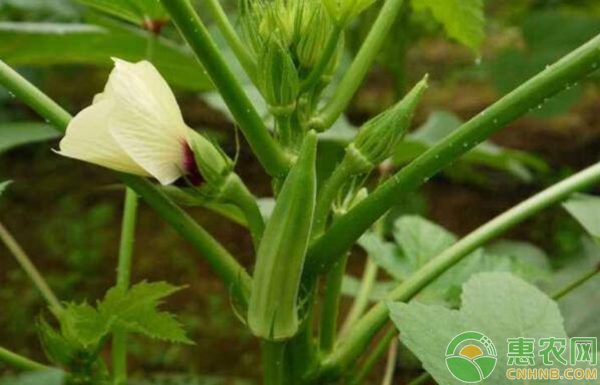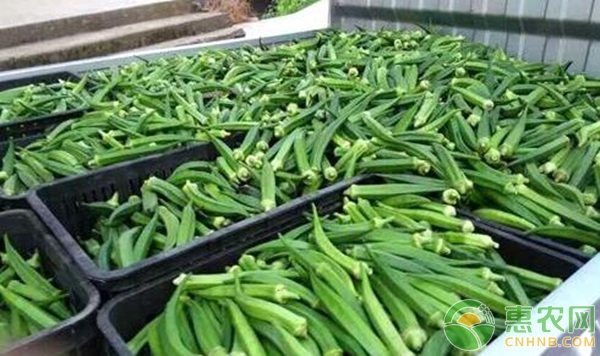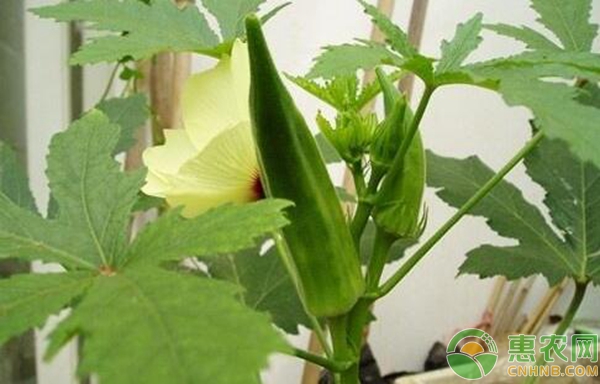Okra's ornamental and edible properties make the okra look promising. If the okra is managed at a minimum yield of at least 2,000 kg per mu, the general market price of supermarkets and hotels is 10-15 yuan per catty. The large amount of wholesale is also at least 5 yuan, we are worth 8 yuan per catty, then about 16,000 yuan per mu, except for seeds, fertilizers, pesticides, management, land rent, can also earn nearly 10,000 yuan per mu. Let's take a look at how the okra is grown! First, the variety selection 1, fruit pod color and fleshy From the color of the fruit, it is divided into two categories: blue and purple. At present, the green-green pods on the market are better in meat quality and are favored by consumers. The purple-red pods are poor and should not be used. 2, plant height 1 dwarf stalk species: plant height about 1m, more side branches, main and side branches can flower; pods early, pods are thick green, pods are sharp, mature pods up to 20cm, with five edges, cross-section is pentagonal; Changlu, Qingfu, Wufu, etc. can be used. 2 stalk species: plant height 1.5m-1.8m, fruit cross section is pentagon, mostly dark green; varieties are Kariba, green arrow, beautiful pentagonal, green five stars, etc., can be used. 3 high stalk species: plant height about 2m, less side branches, green pods, fruit cross-section is five-sided or eight-sided; varieties of Perkins large longhorn, big scorpion, etc., optional. Second, land selection, soil preparation and fertilization 1. Choose a suitable plot: Okra is a short-day plant with strong heat resistance and strong light. Therefore, it is necessary to choose a section with ventilation and sunny sunlight. The roots are deep into the soil, the lateral roots are developed, and the ability to absorb water and fertilizer is strong. Deep soil layer, loose and fertile soil, rich in organic loam or sandy loam; drought-tolerant and moisture-resistant, but not resistant to waterlogging, slightly accumulated water, that is, yellow roots are rotten, planting land needs low groundwater level, good drainage; not heavy, Avoid acidic soil, the soil pH value is 6-6.8 is better; the front hoe is best vegetable garden, cotton sorghum should not be planted, it is not suitable for continuous cropping. (Note: The okra and straw are best smashed back to the field to facilitate the return of certain nutrients to the land). 2. Apply sufficient organic base fertilizer: apply about 2000kg of fully decomposed livestock and poultry per acre, spread the ground before the spring preparation, and then turn into the soil, mix well and mix well to make the soil and fertilizer mix well, which can improve the fertility. It can also improve the soil to meet its growth and development needs (Note: Okra is different from legumes, no rhizobium is found in the roots, so intercropping soybeans can be considered). 3, autumn and winter deep ploughing and drying ridges: ready to plant okra plots, in the early hoe harvest, it is necessary to carry out deep ploughing in autumn and winter, and strive to plough up to 25cm or more, and then fully ridge, frozen ridges to deepen the mature soil layer, Further loosen the soil and enhance the ability of soil water storage and fertilizer retention. 4, ditching to do sputum: before the spring planting, the requirements to achieve fine, flat, loose, soft, on the virtual reality. On this basis, we will do the ditching. Generally, the width of the face is 170cm, the width of the sulcus is 50cm, the sputum and the ditch are added, occupying 220cm, and the sulcus is about 20cm deep. In this way, it is conducive to the wide and narrow planting and management of the okra, and ensure that the drainage is smooth, the field does not accumulate water, and the seedlings are not stained. Third, seed live and seedling transplanting 1. Seed broadcast: Okra can be broadcast live, generally with spring sowing. Because the seed germination, plant growth and development and pod formation are all at 22-35 ° C, so the sowing is not too early, generally when the ground temperature is stable above 16 ° C when the live broadcast is better (Note: low temperature sowing is easy to cause rotten seeds ). The temperature in the south is high in the spring, and can be broadcast live after February; the temperature in the north is low, and the sowing time is suitable in the upper and middle of May; the middle and lower reaches of the Yangtze River are planted in early April, and the coastal areas in Jiangsu and Zhejiang are suitable for planting in late April. The specifics should be based on annual temperature changes). It can also be transplanted with seedlings. If it can be planted in the greenhouse or planted in the field, it can achieve uniform seedlings and prolong its growth period, which is conducive to high yield and quality. 2, shed room nursery time: 20-30 days ahead of Daejeon live broadcast. 3, seedling methods: first of all to soak seeds to promote germination. Soak the seeds in warm water for 24 hours, then wrap them in cloth, place them at 25-30 °C, and sown at about 75%. It can be planted in the shed room seedbed (20kg NPK ternary compound fertilizer per mu of seedbed, fine and flattened, made into a small north-south sorghum, about 1m wide and 4-6cm high. Kneading noodles are required to be high in the north and low in the south, with a drop of 10cm to facilitate the use of light. The planting is about 0.5kg per mu, and the fine soil is covered with 1-1.5cm after sowing. If you can use plastic sputum, seedling tray or nutrient sputum, bag seedlings in the shed, it is better. (Note: Okra seeds and buds are afraid of being soaked for a long time, which is easy to rot) 4. Reasonable close planting: Large-scale planting practice has confirmed that the yield of 4000-6000 plants per acre is the highest. The line spacing is 40cm, and the plant spacing is 15cm. (The dwarf stalk should be slightly dense, and the high stalk species can be thinner). 5, transplanting technology: the key technology when planting is soil transplanting (very important, cotton similar, very afraid of roots), should protect its roots from damage as much as possible. That is to say, seedling bed seedlings should be protected with roots when seedlings are raised; for pots, pots and nutrient bags, keep the pots, pots and bag soils away. The seedling age should not be too long, and the seedlings should not be too large. It is better to have 25 days of seedling age and 2-3 leaves of seedlings; pay attention to the selection of large and small seedlings, and remove the thin seedlings; . 6. Intercropping: Using the different forms and characteristics of okra and strawberry and Chinese cabbage, scientific intercropping can be carried out. For example, 4 rows of okra are planted in the above-mentioned 170cm wide and narrow rows. The organic base fertilizer should be applied in advance and the ground should be used for planting. In the first year, two rows of strawberries are planted in the okra row, and the position of the okra is planted later. Planting Chinese cabbage in time, planting okra after harvesting of Chinese cabbage; when the yellow okra grows up, its lush foliage can cover part of the sunlight, creating a superior ecological environment for the summer of strawberry. This becomes a familiar one, and the benefits are quite good. (Note: 1 Strawberry tends to overlap with Chinese cabbage in the southern season, 2 from the perspective of fertilizer efficiency, soy is also a good choice.) Fourth, strengthen field management 1. Skillful application of top dressing: The okra has a long growth period, and its tender fruit harvesting period can be as long as 100 days. Therefore, in addition to applying the base fertilizer before planting, it should also be applied in time. That is, after transplanting the living tree, it is necessary to apply a seedling fertilizer once, using Jiamei dividend 400g per acre, and pouring 400kg of clear water into the tree. After entering the flowering period, chasing a flower-promoting fertilizer, using 10 to 15 kg of water per mus with Jiamei profit, pouring it to the line. After entering the fruit picking period, it will be applied 1-2 times of strong fruit fertilizer, and each mu of Jiamei will benefit 15-20kg of water to about 1500kg, and will be poured into the line. In addition, the soil in the south is generally deficient in boron, and it should also be noted that the application of boron fertilizer, or the spraying of Jiameijin boron in the leaves. 2. Drought-proof and de-staining: Although okra is drought-tolerant and moisture-tolerant, it must be drought-proof and stain-removing in high-yield and high-efficiency cultivation. Therefore, we must pay attention to keep the soil moist, especially in the harvest period and high temperature and drought. If the drought is found, it is necessary to pour water in time to improve the yield and quality of the tender fruit. In the seedling stage, it is necessary to pay attention to flood control, especially In the rainy season, it is necessary to clear the ditch and drain it so that it is neither wet nor dry during the whole growth period. It is always strong and does not cause premature aging. 3, cultivating and weeding: after topdressing, watering or rainy days, we must weed and weed in time to prevent soil compaction; we should combine the cultivating and clearing ditch to carry out the root-rooting soil to promote the root elongation, so that the plant grows strong and prevents lodging. After cultivating, weeding, and cultivating the soil, it can be terminated after the ridge is closed. 4. Pruning and picking leaves: There are many side buds growing in the lower part of the okra seedlings (especially the dwarf plants). If the planting is dense, the seedlings are full of seedlings, and the excessive side branches will affect the fruit setting, the side buds should be wiped off in time to avoid the consumption of nutrients and improve the ventilation and light transmission in the field; if the seedlings are thin, only some weak branches should be cut off. Leave a thick one to increase the result. After entering the fruiting period, the leaves of the plants are accelerated, and the old leaves and residual leaves should be removed in time to facilitate ventilation and light transmission. The okra root is deep and stable, and there is generally no lodging problem; but in the southern region, after the summer, heavy rain and typhoon are frequent, and there is also the danger of lodging and breaking. Wooden sticks or bamboo rafts should be inserted and tied with the main stalk to prevent losses. 5, pest control: Okra is strong, not many pests and diseases; its leaves and petioles have bristles, but also reduce pests and diseases; cultivation in new vegetable areas, few pests and diseases are found. However, we should pay attention to "prevention first, comprehensive prevention and control" and use agricultural, biological, physical and ecological control methods to control the occurrence of pests and diseases. When chemical pesticides are needed, it is scientific and reasonable to ensure that the pesticide residues in their products are lower than national standards and have no pollution to the ecological environment. V. Scientific harvesting The okra plant height is about 30-50cm, or when the true leaves are 7-8 pieces, it will bloom and pod, and as long as the sun is sufficient, it will gradually bloom and pod. The harvest period is long, generally 60-100 days. 1. Harvesting standards: The total requirements for tender fruits should be hard, tough, green, and bright, and the seeds begin to expand but there are no signs of aging. For the tender pods for fresh food, when the temperature is high, the pods are 7-10 cm long and the transverse diameter is 1.7 cm. When the temperature is low, the pods are 7-9 cm long and the transverse diameter is 1.7 cm. For the processing of the tender pods, length 6-7cm, the transverse diameter of 1.5cm for the grade A; length 8-9cm, the transverse diameter of about 1.7cm for the grade B; pod length of 10cm or more for other products. Regardless of fresh food or processing, the pod length should not exceed 10cm. (Note: only for reference, actual correlation with climate, fertility, variety) 2, harvesting time: generally within 3-7 days after the flower thank you should be harvested (Note: proportional to temperature, high temperature weather, usually not suitable for about three days). When the temperature is high, the tender pods grow fast and need to be harvested every day or harvested every other day; when the temperature is low, they are harvested once every 2-3 days. It is best to cut it every morning and the tender fruit is more tender. 3, harvesting methods: harvesting personnel should wear long pants and long-sleeved shirts, and wear gloves to prevent hand and leg tingling; use scissors to cut from the handle, do not tear by hand to prevent damage to plants Pay attention to the cut, do not miss the cut, such as leakage or late mining, not only the old fruit, poor quality, affecting food and processing, but also affect the growth and development of other tender pods. Immediately after harvesting, the factory will be sent to the factory for quick freezing or the market will be sold immediately. The overnight pods will be quickly lignified, and the appearance and quality will be affected. 4, after harvesting fresh: tender pods have strong respiration, easy to yellow and old after harvest. If it cannot be eaten or processed in time, it should be kept fresh. The tender pods are placed in a plastic bag, flowed in cold water at 4-5 ° C, cooled to about 10 ° C in 10 minutes, and then stored in a 7-10 ° C environment, maintaining 95% relative humidity, can be kept fresh 7-10 day. The tender fruit that is exported to other places must be cut in the morning, put into the storage bag or plastic box, and then gently put into the carton or wooden box, and then sent to the 0-5 °C cold storage for pre-cooling as soon as possible. If the tender pods are dark, soft and yellow, they should be disposed of immediately and cannot be stored.
The lock channel is one of the most important thing for greenhouse, it can lock the film ,shading net ,insect net .
It is hot galvanized or aluminum material.
We have different thickness.
Welcome to contact us
Lock Channel,Greenhouse Lock Channel,Channel Lock,greenhouse profile JIANGSU SKYPLAN GREENHOUSE TECHNOLOGY CO.,LTD , https://www.skyplantgreenhouse.com


